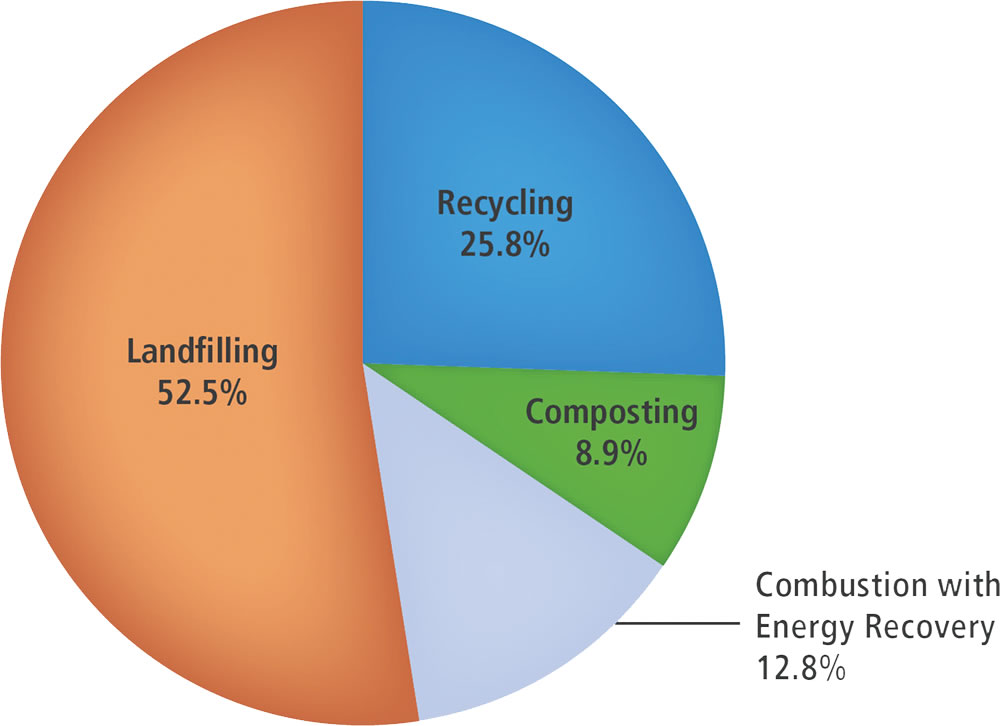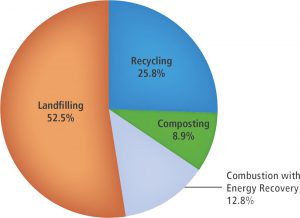BioCycle August 2018
2015 MSW Fact Sheet
The U.S. EPA released “Advancing Sustainable Materials Management: 2015 Fact Sheet” in July 2018, the agency’s annual report on trends in municipal solid waste (MSW) generation, recycling, disposal and combustion. Highlights include:
• 39.73 million tons of food waste were generated, and 2.10 million tons were composted (5.3%); 30.25 million tons of food waste were landfilled (76.1%) and 7.38 million tons (18.6%) were combusted.
• 34.72 million tons of yard trimmings were generated, of which 21.29 million tons (61.3%) were composted. About one-third of generated yard trimmings (10.80 million tons or 31.1%) were landfilled.
Duke Dining Bans Disposable Plastic
As of July 1, 2018, all dining locations on Duke University’s campus in Durham, North Carolina are no longer allowed to carry single-use plastic carryout bags, plastic hot and cold beverage cups, plastic straws and plastic utensils. In recent years, Duke Dining also has eliminated use of bleached paper products and Styrofoam. “Sustainability isn’t optional for Duke Dining; it’s who we are and how we define ourselves,” notes Robert Coffey, director of Duke Dining. “The disposable plastics ban is another step in the right direction.”
Dining venues, including vendors, on Duke’s campus will now use paper bags and utensils, straws and drinkware made from polylactic acid (PLA), a biodegradable plastic. “It is very exciting because everybody understood why it was important and everybody was excited to get the tools that they needed to implement it,” says Marcus Carson, assistant director of Duke Dining for Sustainability and Quality Control. Duke Dining earned a national award in 2017 for its procurement practices. The ban on plastic was inspired, in part, by a national movement to eliminate the use of plastic drinking straws often used but rarely recycled.
“My thinking was, ‘Why stop at just straws, why not go a step further?’” adds Carson. “We have composting infrastructure and we have a pretty robust recycling infrastructure on campus. And there are compostable and recyclable alternatives for these products out there and the price point has come down significantly from when they were introduced. I thought it was a good time for Duke to stand as a leader in this space and make the full push.”
2017 Landfill Tipping Fees Report
The Environmental Research & Education Foundation (EREF) maintains a database of 1,540 active Subtitle D MSW landfills across the U.S. This database was used to draw a sample of active facilities for analysis of MSW landfill (MSWLF) tipping fees. Landfill owners were contacted and asked to provide gate rate information on their tipping fee for MSW disposal. For the purpose of this report, notes EREF, the terms gate rate, tip fee, and tipping fee are used interchangeably to refer to the per-ton fee for hauled MSW loads. The MSWLF database was also used to categorize landfills as large, medium, or small based on their yearly amount of waste disposed. The following information was excerpted from the tipping fee report.
Of the 400 landfills providing gate rate information, 55 (14%) were large (i.e. accepting >390,000 tons/year (tpy)); 181 (45%) were medium (i.e. accepting between 390,000 and 65,000 tpy); and 164 (41%) were small (i.e. accepting <65,000 tpy). The large landfills reporting 2017 tip fee data accepted an average of 769,000 tpy, while medium and small landfills accepted 164,000 tpy and 28,000 tpy on average, respectively.
For 2017, the national MSW landfill tip fee average was $51.82/ton. Based on EREF’s 2016 analysis, the national average tip fee increased by 6.5 percent from $48.27 to $51.82/ton. The highest average regional tipping fee was in the Northeast ($67.27/ton), which overtook the Pacific region to be most expensive for MSWLF disposal in 2017. The South Central region had the lowest average tip fee ($36.94/ton), and was the only region where average tip fee was under $40/ton for 2017. On a state basis, there was substantial variation in MSW tipping fee. Average state MSWLF tipping fee ranged from $21.67/ton (Mississippi, Southeast region) to $200/ton (Connecticut, Northeast region).
Oregon’s Metro Council Votes To Ban Food Scraps
Metro Council, a regional government authority based in Portland, Oregon, voted unanimously in late July in favor of an ordinance that will require some types of businesses in greater Portland to separate their food scraps from the garbage. Starting in March 2020, businesses that generate 1,000 pounds or more of food scraps per week must collect them separately from garbage. The program will roll out over five years. Eventually, almost 3,000 businesses and institutions, including schools, will be required to separate their food scraps. Businesses that generate less than 250 pounds of food scraps per week will not be subject to the requirement.
The vote comes after more than a decade of voluntary participation by some businesses in food scraps collection programs. But the amount of food scraps diverted from the landfill stalled out at about 24,000 tons/year, notes a Metro news release. The expectation is that under the new ordinance, about 59,000 tons/year of food scraps will be collected when the ordinance is fully implemented.
Since 2016, Metro has reached out to hundreds of businesses, property managers, local government officials and others to get input on the policy. According to a survey conducted last September, business owners were mostly supportive but worried about things like increased costs, odors, and space for storing extra bins. “We reduced our garbage bill, so that was a nice bonus,” said Punky Scott, owner of the Bomber Restaurant near Milwaukie. Having food-waste-only bins also made it clear that some serving portions were too large, so the restaurant cut back. So far, she told Metro Council, “nobody has said, ‘I’m only getting two-thirds of my tater tots.’”
One recurring question has been how the new system will work for communities in Washington County, which may be far from the (proposed) food scrap processing centers, and thus be expensive and, because of traffic, very slow for waste haulers. To address this, upcoming draft administrative rules, to be released for public comment this fall, will include a payment mechanism to help offset transportation costs for garbage haulers that collect from areas farther away from transfer stations.
CalRecycle Awards $25 Million In Grants
The California Department of Resources Recycling and Recovery (CalRecycle) awarded $25 million to 10 grant recipients to further diversion of organics in California. Maximum Organics Grant awards are $4 million for anaerobic digestion projects and $3 million for composting projects. Several of the projects include a food rescue component.
Awarded projects fall into four general categories:
New composting infrastructure, e.g., Burrtec Waste Industries, Inc. received $3 million to construct a new covered composting system at a material recovery facility (MRF) and transfer station near Riverside. West Coast Waste will construct a new aerated static pile (ASP) composting facility to divert currently landfilled green material ($1.36 million in current and previous grant rounds).
Upgrades or expansions of existing infrastructure, e.g., Athens Services is upgrading its Victorville windrow composting facility to an ASP system ($3 million). Upper Valley Disposal Services is constructing a new “organics blending barn” to mix food, green, and wood waste for composting, and is developing a food rescue partnership with Sacramento Food Bank and Family Services ($1.25 million).
New or expanded AD infrastructure, e.g., CR&R Inc. was awarded $4 million for constructing the third phase of a 3-phase project at its AD facility in Perris. Santa Barbara County is developing an AD facility to process currently landfilled organics into biogas and compost ($4 million).
Purchase of contaminant removal equipment, e.g., Advance Disposal Co. is installing equipment at its MRF in Hesperia to remove contaminants from organic waste to divert to composting ($2.4 million). Waste Management of Alameda County is purchasing preprocessing equipment for a new organics recovery facility in San Leandro, with separated organics to be composted at a new facility colocated at the Davis Street complex. Grant includes food rescue partnership with Alameda County Community Food Bank ($3 million).
Waste Authority Opts For Food Waste Codigestion
The Oneida Herkimer Solid Waste Authority (Authority) in Utica, New York, is collaborating with the Oneida County Water Pollution Control Facility (WPCF) to manage food waste that is currently landfilled. A feasibility study conducted by the Authority in 2016 found that generators in Oneida and Herkimer counties produce approximately 15,000 tons/year of commercial, industrial, and institutional food waste. These generators are the initial target of the Authority’s new Source Separated Organics (SSO) collection program.
To process the organics, a 4,900 square foot Source Separated Organics Processing Facility (SSOPF) is being constructed at the Authority’s Eastern Transfer Station. The SSOPF will be sized to manage up to 22,000 tons/year of organics. This facility will house a Scott Equipment THOR Turbo OS-100 processor, which has capacity to process and depackage between 5 to 72 tons/day of material. The resulting slurry will be sent next door to the Oneida County WPCF, blended with biosolids, and processed in two egg shaped anaerobic digesters (1.2 million gallons each). Biogas from the digesters is expected to produce the energy required to power the WPCF.
The Authority is optimistic about participation in the upcoming SSO program, in part because it plans to lower the SSO tipping fee to $40/ton, a significant decrease from the current MSW tip fee of $62/ton. The Authority received $1,327,500 in funding for this project from the New York State Department of Environmental Conservation (NYSDEC) Climate Smart Communities Grant, and a $276,400 grant from NYSDEC to purchase the THOR separator. The SSOPF will be operational in first quarter 2019.











